Authorization Letter To Use Car
[Your Name]
[Your Address]
[City, State, ZIP Code]
[Date]
[Recipient's Name]
[Recipient's Address]
[City, State, ZIP Code]
Subject: Authorization Letter to Use My Car
Dear [Recipient's Name],
I am writing this letter to grant you authorization to use my car, [Car Make and Model], with license plate number [License Plate Number], for the period of [Start Date] to [End Date]. The purpose of this authorization is [briefly explain the reason for using the car, such as a business trip, personal use, etc.].
I understand and acknowledge that you will be responsible for the vehicle during the specified period, including any expenses, maintenance, and adherence to all traffic rules and regulations. Please be aware that this authorization is granted under the following conditions:
1. You must possess a valid driver's license and adhere to all applicable laws and regulations related to driving and vehicle usage.
2. The vehicle should be used only for the purposes specified in this letter.
3. Any damages or incidents that occur during the authorized period will be your responsibility, and you should take appropriate steps to address them.
4. The vehicle should be returned to me in the same condition as it was at the time of authorization, barring normal wear and tear.
5. You are not permitted to sub-authorize or lend the vehicle to any other individuals without my explicit consent.
6. This authorization does not transfer ownership or title of the vehicle.
Please note that any violations of the above conditions will result in the revocation of this authorization. Should you encounter any issues during your use of the vehicle, please contact me immediately at [Your Phone Number] or [Your Email Address].
I kindly request you to sign a copy of this letter as acknowledgement of your agreement to the terms and conditions outlined herein. Please find an attached copy of your signed acknowledgment for your records.
Thank you for respecting these terms and for your responsible use of my vehicle.
Sincerely,
[Your Signature]
[Your Printed Name]
Acknowledgment of Authorization and Agreement:
I, [Recipient's Name], hereby acknowledge that I have read and understood the terms and conditions outlined in the above Authorization Letter to Use Car provided by [Your Name]. I agree to adhere to these conditions and take full responsibility for the authorized use of the vehicle.
Signature: ____________________
Date: ____________________
Authorization Letter for Personal Vehicle Use by Family Member
Subject: Authorization to Use Vehicle
Dear [Recipient/Authority],
I, [Your Full Name], holder of [Driver's License Number], am the registered owner of [Vehicle Make and Model], with registration number [Vehicle Registration Number].
I hereby authorize [Authorized Person's Full Name], holder of [Driver's License Number], to use and operate the above-mentioned vehicle on my behalf from [Start Date] to [End Date/Until Further Notice].
This authorization includes permission to drive the vehicle for [personal use/commuting/errands/specific purpose]. The authorized driver is covered under my insurance policy [Policy Number] with [Insurance Company Name].
Please consider this letter as formal authorization for [Authorized Person's Name] to present to traffic authorities, insurance companies, or any other relevant parties as needed.
Sincerely,
[Your Full Name]
[Your Address]
[Contact Number]
[Date]
Authorization Letter for Employee to Use Company Vehicle
Subject: Company Vehicle Authorization
To Whom It May Concern,
This letter serves to authorize [Employee Name], [Job Title] with employee ID [Employee ID Number], to operate company vehicle [Vehicle Make and Model], registration number [Registration Number], for official business purposes.
The authorization is effective from [Start Date] and remains valid until [End Date/revocation]. The authorized driver is permitted to use this vehicle for:
- Client meetings and site visits
- Business travel within [specified region/state/country]
- Transportation of company materials and equipment
- Other duties as assigned by management
The employee has been verified to hold a valid driver's license [License Number] and has completed our corporate driver safety training program. All usage must comply with company vehicle policies and traffic regulations.
This authorization may be revoked at any time at the company's discretion.
[Company Name]
[Authorized Signatory Name]
[Title]
[Company Seal]
[Date]
Temporary Authorization Letter for Emergency Vehicle Use
Subject: Emergency Vehicle Use Authorization
To Traffic Authorities and Relevant Officials,
Due to an urgent situation, I, [Your Name], owner of vehicle [Make and Model], registration [Number], hereby grant temporary authorization to [Authorized Person's Name] to operate my vehicle.
Emergency circumstances: [Brief description - medical emergency/family crisis/stranded situation]
Duration of authorization: [Specific dates or "until emergency is resolved"]
The authorized individual holds valid license number [License Number] and is insured to drive this vehicle under my policy. This letter serves as immediate proof of permission and should be honored by all relevant authorities.
Emergency contact: [Your Phone Number]
[Your Signature]
[Your Name]
[Date]
Authorization Letter for Valet Parking Services
Subject: Valet Service Authorization
Dear [Hotel/Restaurant/Venue Name],
I, [Your Full Name], authorize your professional valet parking service to operate my vehicle [Make, Model, Color] with registration number [Registration Number] during my visit on [Date/Dates].
This authorization includes:
- Parking and retrieving the vehicle
- Moving the vehicle as necessary for parking operations
- Standard valet service procedures
My vehicle is insured under policy [Policy Number] with [Insurance Company]. I understand that your establishment maintains appropriate liability coverage for valet operations.
Please ensure that only trained and authorized valet staff operate my vehicle.
Guest Name: [Your Name]
Contact: [Phone Number]
Date: [Date]
Authorization Letter for Vehicle Use During Owner's Absence
Subject: Vehicle Use Authorization During Travel
To Whom It May Concern,
I, [Your Name], will be traveling abroad/out of state from [Start Date] to [End Date]. During my absence, I authorize [Authorized Person's Name], my [relationship - friend/sibling/colleague], to use and maintain my vehicle [Make and Model], registration [Number].
The authorized person may use the vehicle for:
- Regular maintenance appointments
- Personal transportation needs
- Emergency situations requiring vehicle access
All necessary documents including registration, insurance card [Policy Number with Insurance Company], and maintenance records are located [location in vehicle]. The authorized driver has my permission to present this letter to law enforcement, insurance representatives, or service providers as needed.
I can be reached at [International Contact Number/Email] if verification is required.
Respectfully,
[Your Signature]
[Your Name]
[Date]
[Witness Signature - Optional]
Authorization Letter for Minor to Drive Parent's Vehicle
Subject: Parental Authorization for Vehicle Use
Dear Officer/Official,
I, [Parent's Full Name], am the legal guardian and registered owner of [Vehicle Make and Model], license plate [Number]. I hereby authorize my son/daughter, [Minor's Full Name], date of birth [DOB], to operate this vehicle.
My child holds a valid [learner's permit/junior license] number [License Number] issued by [State/Authority]. They are listed as an authorized driver on our family insurance policy [Policy Number] with [Insurance Company].
This authorization confirms parental consent for my minor child to drive the family vehicle in accordance with all applicable laws, licensing restrictions, and curfew requirements for junior drivers.
Parent/Guardian Information:
Name: [Your Name]
Address: [Full Address]
Contact: [Phone Number]
Date: [Date]
[Parent's Signature]
Authorization Letter for Mechanic to Test Drive Vehicle
Subject: Authorization for Vehicle Test Drive
Dear [Service Center/Mechanic Name],
I, [Your Name], owner of [Vehicle Year, Make, Model], VIN [Vehicle Identification Number], registration [Registration Number], authorize your certified mechanics to test drive my vehicle as necessary to diagnose and repair the reported issues.
Service appointment: [Date]
Reported problems: [Brief description]
Your technicians have permission to:
- Operate the vehicle on public roads for diagnostic purposes
- Perform test drives before and after repairs
- Move the vehicle within your facility premises
My insurance policy [Policy Number] with [Insurance Company] covers authorized repair facility operations. Please ensure that only licensed and insured technicians operate my vehicle.
I understand that test drives will be limited to reasonable distances necessary for proper diagnosis and repair verification.
Vehicle Owner: [Your Name]
Contact: [Phone Number]
Date: [Date]
Formal Authorization Letter for Cross-Border Vehicle Use
Subject: Authorization for International Vehicle Travel
To Border Control Authorities and Relevant Officials,
I, [Your Full Name], passport number [Passport Number], am the legal owner of vehicle [Make, Model, Year], with registration number [Registration Number], registered in [Country/State].
I hereby authorize [Authorized Driver's Full Name], passport number [Passport Number], to operate my vehicle for cross-border travel between [Country A] and [Country B] for the period of [Start Date] to [End Date].
Purpose of travel: [Business/Tourism/Family Visit/Other]
The authorized driver holds a valid international/domestic driver's license [License Number] and is covered under my insurance policy [Policy Number] which includes international coverage.
All necessary documentation including vehicle registration, insurance certificate, and this authorization letter will be carried in the vehicle at all times.
Owner's Information:
Full Name: [Your Name]
Address: [Full Address]
Contact: [Phone Number]
Email: [Email Address]
[Your Signature]
[Date]
[Notarization - if required]
What is an Authorization Letter to Use a Car and Why is it Needed?
An authorization letter to use a car is a formal document where a vehicle owner grants permission to another individual to operate their vehicle. This letter serves as legal proof of consent and protects both the owner and the authorized driver from potential legal complications.
The primary purposes include:
- Providing legal documentation that the driver has owner's permission
- Protecting against theft or unauthorized use accusations
- Satisfying insurance company requirements
- Meeting law enforcement documentation needs
- Establishing clear terms and boundaries for vehicle use
- Creating a paper trail for liability purposes
- Enabling legitimate use without the owner being present
When Do You Need an Authorization Letter to Use a Car?
Authorization letters are required or highly recommended in numerous situations:
- Family situations: When a spouse, child, or relative needs to use your vehicle regularly or temporarily
- Emergency circumstances: Medical emergencies requiring immediate vehicle access by someone other than the owner
- Travel and absence: When the owner is traveling abroad or away for extended periods
- Employment purposes: Allowing employees to drive company vehicles for business operations
- Maintenance and repairs: Authorizing mechanics or service centers to test drive your vehicle
- Valet services: Granting permission to hospitality staff to park and move your vehicle
- Cross-border travel: When someone else drives your car across state or international borders
- Minor drivers: When teenage children with learner's permits need parental authorization
- Car sharing arrangements: Informal arrangements between friends or neighbors
- Rental property situations: When tenants need to use vehicles provided with rental properties
- Diplomatic or official use: When vehicles are used for official government or corporate purposes
Essential Elements and Structure of a Car Authorization Letter
A comprehensive authorization letter should include the following components:
Opening Section:
- Clear subject line indicating the letter's purpose
- Date of issuance
- Formal greeting
Owner Information:
- Full legal name of the vehicle owner
- Driver's license number
- Contact information (address, phone, email)
- Relationship to authorized driver (if applicable)
Vehicle Details:
- Make, model, and year of the vehicle
- Vehicle registration number/license plate
- VIN (Vehicle Identification Number) for formal situations
- Color and any distinguishing features
Authorized Driver Information:
- Full legal name of the person being authorized
- Driver's license number and issuing state/country
- Passport number (for international travel)
- Relationship to owner
Authorization Scope:
- Specific dates or duration of authorization
- Geographic limitations (local, state-wide, international)
- Permitted uses (personal, business, emergency only)
- Any restrictions or conditions
Insurance Details:
- Insurance company name
- Policy number
- Confirmation that authorized driver is covered
Closing Section:
- Signature of vehicle owner
- Date of signature
- Witness signature (optional but recommended)
- Notarization (for international or high-stakes situations)
Who Should Write and Sign a Car Authorization Letter?
The letter must be written and signed by:
- The registered owner of the vehicle as listed on the title and registration
- All co-owners if the vehicle has multiple registered owners
- The legal guardian if the vehicle is registered to a minor
- An authorized representative with power of attorney (in specific circumstances)
For company vehicles:
- The authorized company signatory (typically HR manager, fleet manager, or executive)
- Someone with legal authority to bind the company
- The letter should include company letterhead and official seal
For leased vehicles:
- The lessee (person leasing the vehicle) must provide authorization
- Check lease agreement terms as some leases restrict who can drive
- May require additional permission from leasing company
Special circumstances:
- If owner is incapacitated: Person with power of attorney can authorize
- If owner is deceased: Executor of estate may provide authorization during probate
- For jointly owned vehicles: All owners should ideally sign
How to Write and Send a Car Authorization Letter
Step 1: Gather necessary information
- Collect all vehicle documentation (registration, insurance card, title)
- Obtain authorized driver's license information
- Determine specific dates and scope of authorization
Step 2: Choose appropriate format
- Use formal business letter format for official purposes
- Ensure clarity and professional tone
- Include all essential elements mentioned in structure section
Step 3: Draft the letter
- State the purpose clearly in the opening
- Provide complete vehicle and driver details
- Specify terms, conditions, and limitations
- Include insurance information
- Add contact details for verification
Step 4: Review and verify
- Double-check all numbers (license plates, policy numbers, license numbers)
- Ensure dates are accurate and reasonable
- Verify that all required information is included
Step 5: Sign and document
- Sign in blue or black ink
- Consider having signature witnessed
- Get notarized for international travel or high-value vehicles
Step 6: Distribution
- Provide original to authorized driver
- Keep a copy for your records
- Send copy to insurance company if required
- Email PDF copy to authorized driver for backup
Requirements and Prerequisites Before Writing the Letter
Legal requirements:
- Verify you are the legal registered owner of the vehicle
- Ensure the authorized driver has a valid driver's license
- Confirm your insurance policy covers additional drivers
- Check if your state/country requires notarization
Documentation needed:
- Vehicle registration certificate
- Proof of insurance
- Your driver's license
- Authorized driver's license information
- Vehicle identification documents
Insurance considerations:
- Contact your insurance company to add authorized driver
- Verify coverage extends to the authorized person
- Understand any premium changes or deductible implications
- Obtain written confirmation of coverage
For company vehicles:
- Review company vehicle use policy
- Ensure driver has completed required safety training
- Verify driver meets company insurance requirements
- Obtain necessary internal approvals
For international travel:
- Research destination country's requirements
- Obtain international driving permit if needed
- Verify insurance covers cross-border travel
- Check visa and customs regulations
Formatting Guidelines for Car Authorization Letters
Length and style:
- Keep letter concise: typically one page (250-400 words)
- Use clear, formal language without ambiguity
- Avoid jargon unless necessary for legal precision
- Maintain professional tone throughout
Preferred tone by situation:
- Official/Legal situations: Formal, precise, business tone
- Family arrangements: Semi-formal but clear tone
- Emergency situations: Direct and urgent tone
- Business use: Corporate professional tone
Physical formatting:
- Use standard business letter format
- Print on white paper for physical copies
- Use readable font (Times New Roman or Arial, 11-12pt)
- Include adequate margins (1 inch all sides)
- Single-space with double-space between paragraphs
Mode of delivery:
- Physical letter: For notarized versions, legal proceedings, official use
- Email/Digital: For quick authorization, backup copies, international verification
- Both: Recommended for important authorizations
Essential etiquette:
- Always keep authorization current and dated
- Revoke in writing when no longer applicable
- Be specific about limitations to avoid misunderstandings
- Provide contact information for verification
- Keep language respectful and professional
What to Do After Sending the Authorization Letter
Immediate follow-up actions:
- Confirm the authorized driver received the letter
- Ensure they carry the letter in the vehicle at all times
- Provide both physical and digital copies
- Share your contact information for verification purposes
Insurance notifications:
- Inform your insurance company about the authorization
- Request written confirmation that driver is covered
- Understand any changes to your policy or premiums
- Keep insurance company's emergency contact handy
Documentation management:
- File a copy with your vehicle documents
- Store digital backup in cloud storage
- Note authorization dates in your calendar
- Set reminders for expiration if temporary
Monitoring and oversight:
- Establish clear communication with authorized driver
- Discuss expectations about vehicle care and fuel
- Agree on procedures for accidents or emergencies
- Determine how expenses will be handled
Revocation procedures:
- Know that you can revoke authorization at any time
- Put revocation in writing immediately
- Notify insurance company of revocation
- Collect the vehicle and all copies of authorization letter
- Inform relevant authorities if necessary (for official use)
Common Mistakes to Avoid When Writing Authorization Letters
Information errors:
- Incorrect vehicle registration or VIN numbers
- Wrong driver's license numbers or expiration dates
- Misspelled names or addresses
- Inaccurate insurance policy numbers
- Omitting critical identification details
Scope and clarity issues:
- Vague authorization periods ("whenever needed" instead of specific dates)
- Unclear geographic limitations
- Ambiguous purpose statements
- Missing restrictions or conditions
- Failing to specify revocation conditions
Legal and insurance oversights:
- Not verifying insurance coverage before authorizing
- Forgetting to notify insurance company
- Failing to get notarization when required
- Authorizing someone with suspended or expired license
- Not checking if driver meets insurance requirements
Documentation problems:
- Not keeping copies for your records
- Failing to provide backup digital copies
- Missing signatures or dates
- Illegible handwriting or poor print quality
- Not updating expired authorizations
Communication failures:
- Not establishing clear expectations with authorized driver
- Failing to provide contact information for verification
- Not discussing accident procedures
- Assuming driver understands limitations without explicit discussion
Advantages and Disadvantages of Car Authorization Letters
Advantages:
- Provides legal protection for both owner and driver
- Prevents theft or unauthorized use accusations
- Satisfies law enforcement and insurance requirements
- Creates clear documentation trail
- Establishes boundaries and expectations
- Enables legitimate vehicle use when owner unavailable
- Protects insurance coverage and claims
- Demonstrates responsible vehicle ownership
- Can be easily revoked when circumstances change
Disadvantages:
- Requires time and effort to prepare properly
- May increase insurance premiums when adding drivers
- Creates potential liability exposure for vehicle owner
- Requires ongoing management and monitoring
- Can be misused if not properly limited
- May need notarization, adding cost and inconvenience
- Doesn't eliminate all legal risks
- Requires trust in authorized driver's judgment
- Can complicate accident or damage situations
- May create dependency or expectation of continued access
Tips and Best Practices for Car Authorization Letters
Smart authorization strategies:
- Set clear expiration dates rather than open-ended authorizations
- Include specific mileage limits for clarity and accountability
- Photograph vehicle condition before and after authorization period
- Create standardized templates for recurring authorizations
- Use registered mail for official or notarized versions
Protection measures:
- Always verify driver's license validity before authorizing
- Consider requiring security deposit for non-family members
- Establish written agreement about damage responsibility
- Keep detailed records of vehicle condition and mileage
- Review insurance deductible with authorized driver
Communication excellence:
- Discuss expectations about fuel, cleanliness, and maintenance
- Establish emergency contact protocols
- Share vehicle quirks or special operating instructions
- Agree on accident reporting procedures
- Clarify who pays for parking tickets or violations
Professional touches:
- Use company letterhead for business authorizations
- Include multiple contact methods for verification
- Attach copies of relevant insurance documents
- Add witness signatures for high-value vehicles
- Consider including photo ID copies for international travel
Time-saving shortcuts:
- Create reusable templates for common scenarios
- Keep digital copies readily accessible
- Maintain updated file with all vehicle information
- Use electronic signatures when legally acceptable
- Pre-print forms for frequently authorized drivers
Comparison with Alternative Authorization Methods
Authorization letter vs. Adding driver to insurance:
- Letter is temporary and easily revoked; insurance addition is more permanent
- Insurance addition provides better coverage but costs more
- Letter works for occasional use; insurance for regular drivers
- Both may be required simultaneously for complete protection
Authorization letter vs. Verbal permission:
- Written authorization provides legal proof; verbal doesn't
- Letter protects against misunderstandings
- Written form required by most authorities and insurance
- Verbal permission has no evidentiary value in disputes
Authorization letter vs. Power of Attorney:
- Power of attorney is broader and covers many decisions
- Authorization letter is vehicle-specific and limited
- POA requires legal formalities; authorization letter is simpler
- POA suitable for extended incapacity; letter for temporary needs
Authorization letter vs. Title transfer:
- Title transfer changes legal ownership permanently
- Authorization maintains owner's rights and control
- Transfer involves DMV paperwork and fees; letter doesn't
- Letter appropriate for temporary use; transfer for permanent change
Physical letter vs. Digital authorization:
- Physical letter better for official use and traffic stops
- Digital easier to share and store as backup
- Both recommended for comprehensive protection
- Physical version required when notarization needed
Frequently Asked Questions About Car Authorization Letters
How long is an authorization letter valid? The letter is valid for whatever period the owner specifies. It can range from a single day to several years, though shorter, specific periods are recommended for better control and reduced liability.
Can I authorize multiple people on one letter? Yes, but it's generally better to issue separate letters for each authorized driver to maintain clarity and easier revocation if needed for specific individuals.
Do I need to notarize the authorization letter? Notarization isn't always required but is highly recommended for international travel, high-value vehicles, or situations where the letter may face legal scrutiny.
What happens if the authorized driver gets in an accident? Your insurance typically covers authorized drivers, but liability depends on circumstances and your policy terms. Both you and the driver may share responsibility depending on policy language.
Can rental car companies require authorization letters? Rental companies have their own policies. If you're allowing someone else to drive your rental, check the rental agreement as most companies require additional drivers to be listed on the contract.
Is an authorization letter legally binding? Yes, it's a legal document that grants permission and establishes terms. It can be used as evidence in legal proceedings related to vehicle use.
Can I revoke authorization immediately? Yes, vehicle owners can revoke authorization at any time by providing written notice. Collect all copies of the original letter and notify your insurance company.
Does the letter protect me from all liability? No, as the owner you may still have some liability. The letter helps establish that use was authorized, but doesn't eliminate all legal responsibility for vehicle-related incidents.

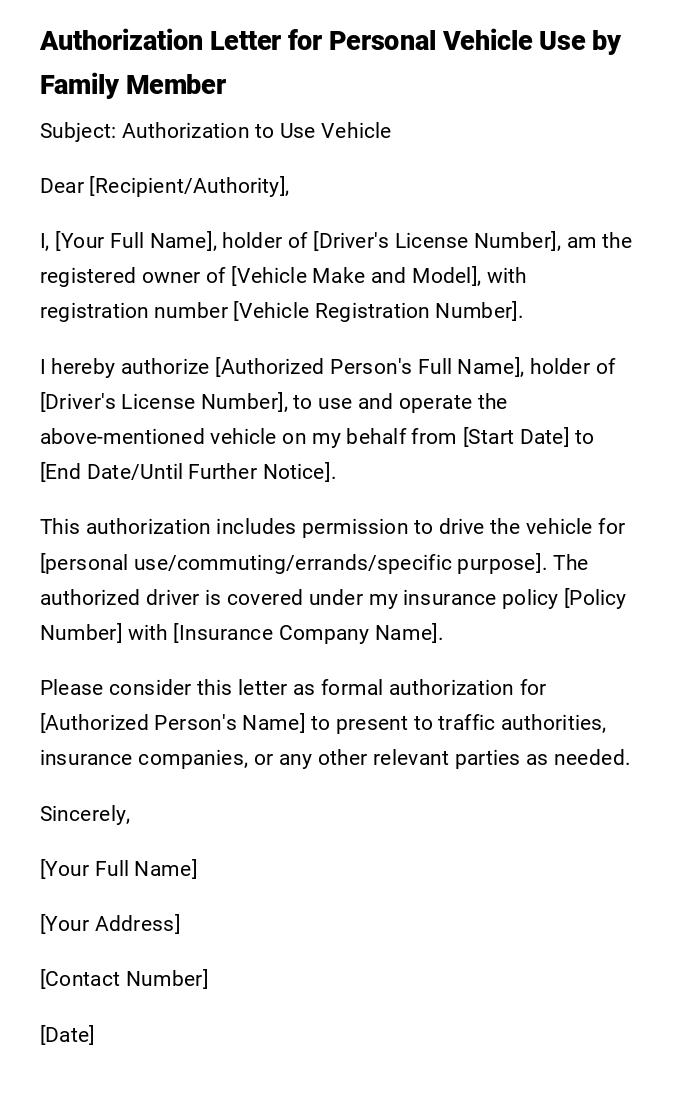
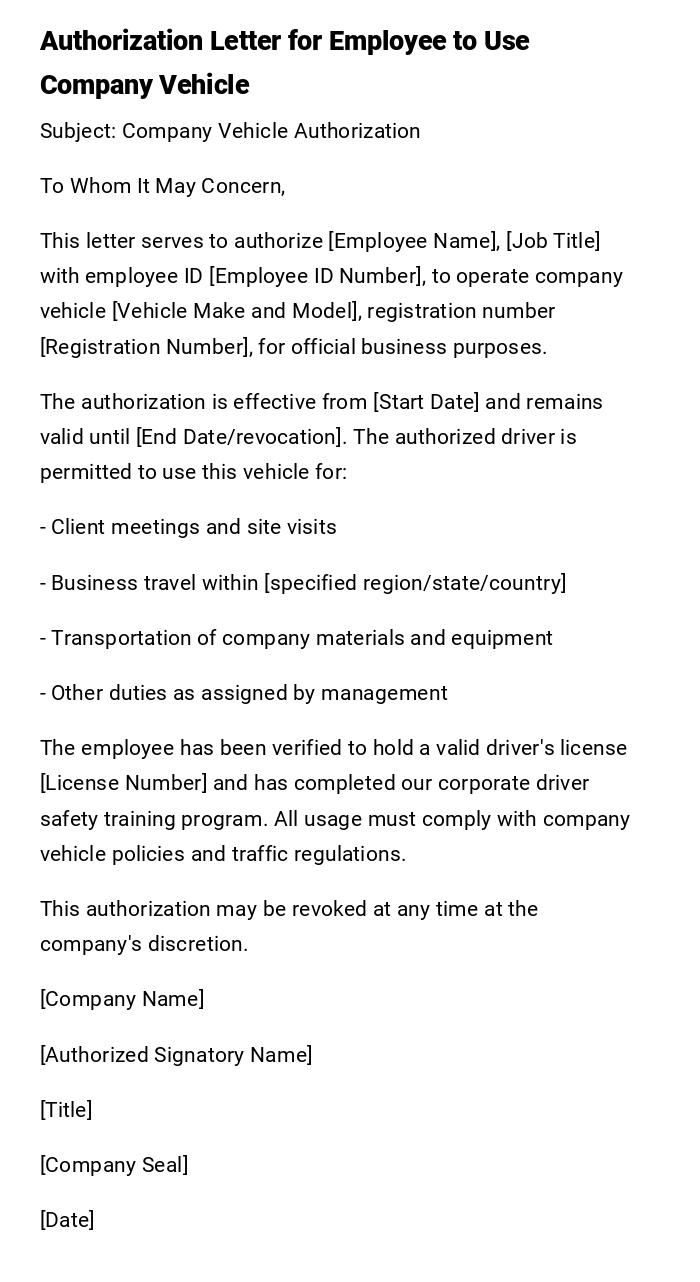
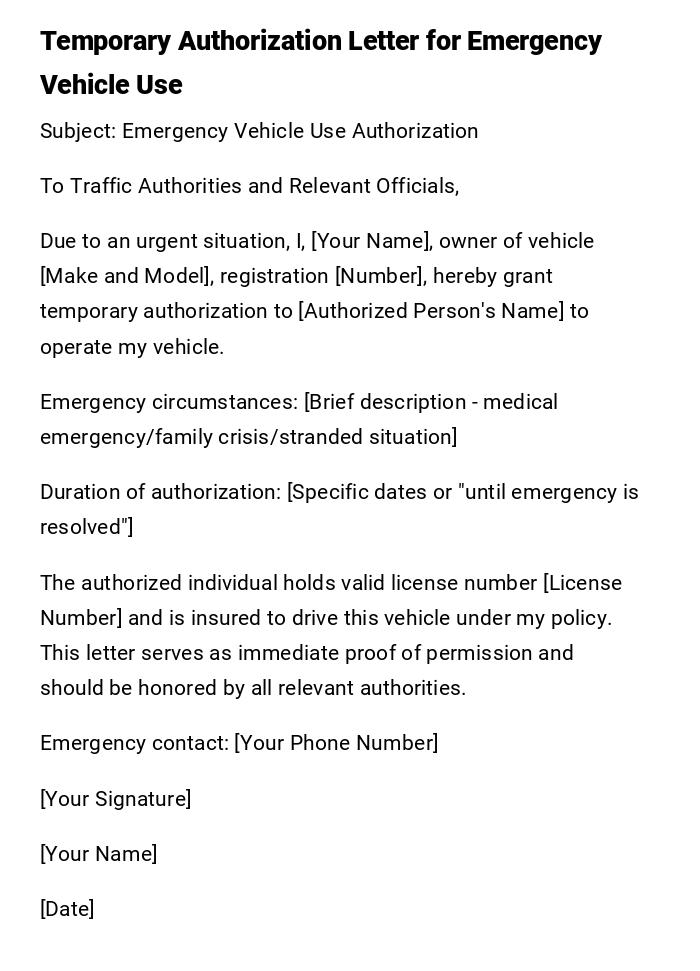
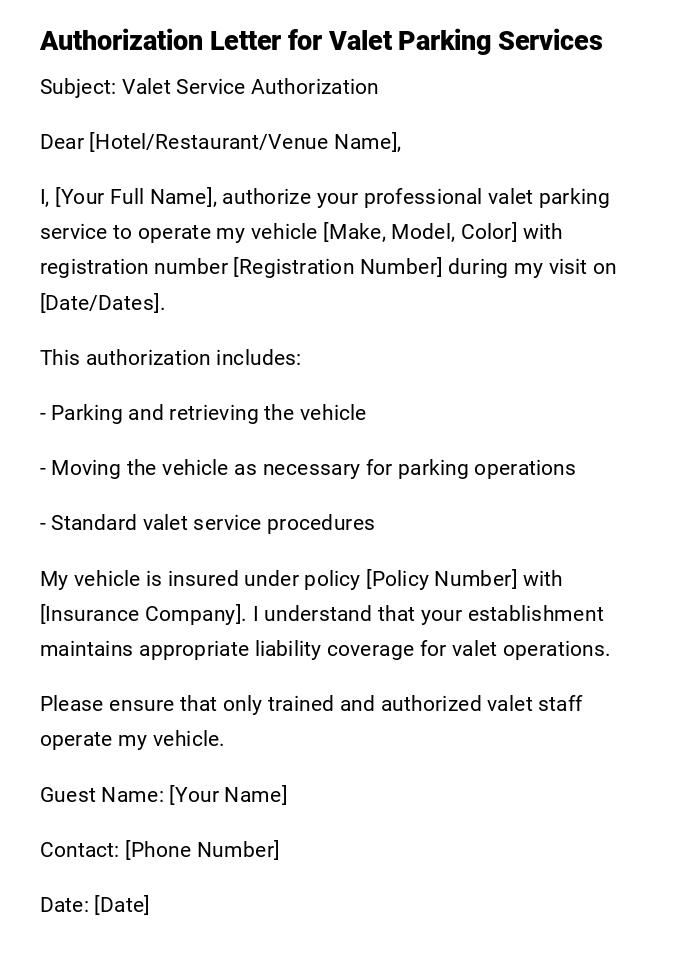
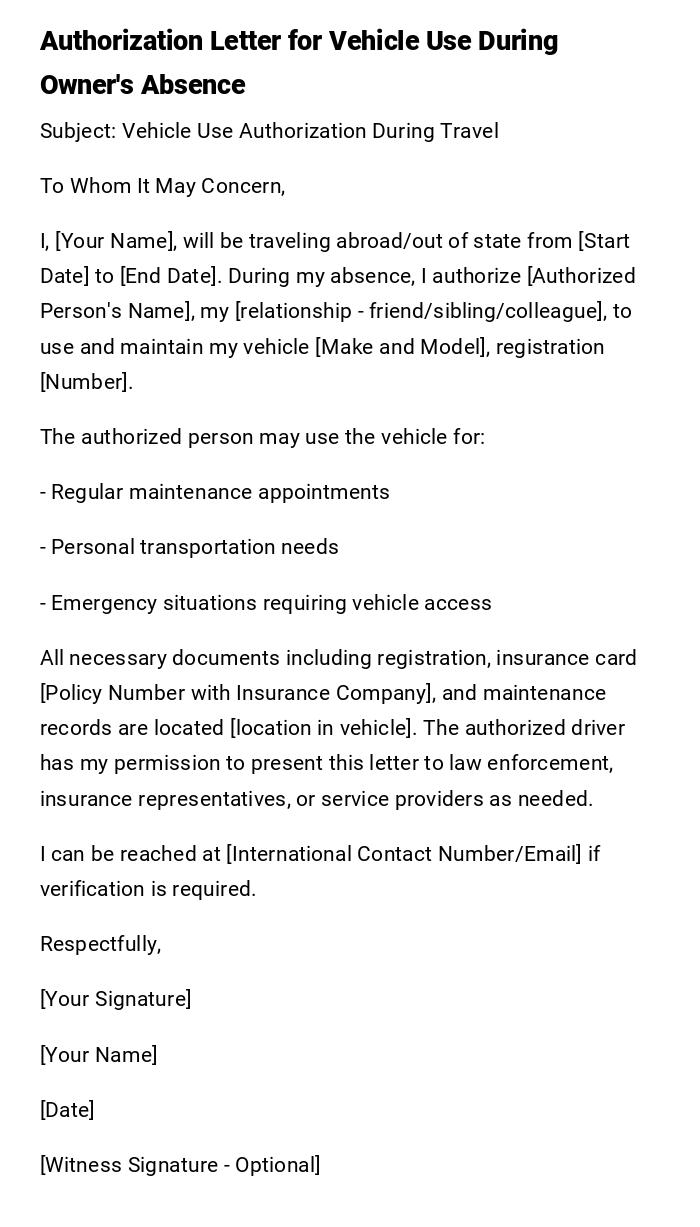
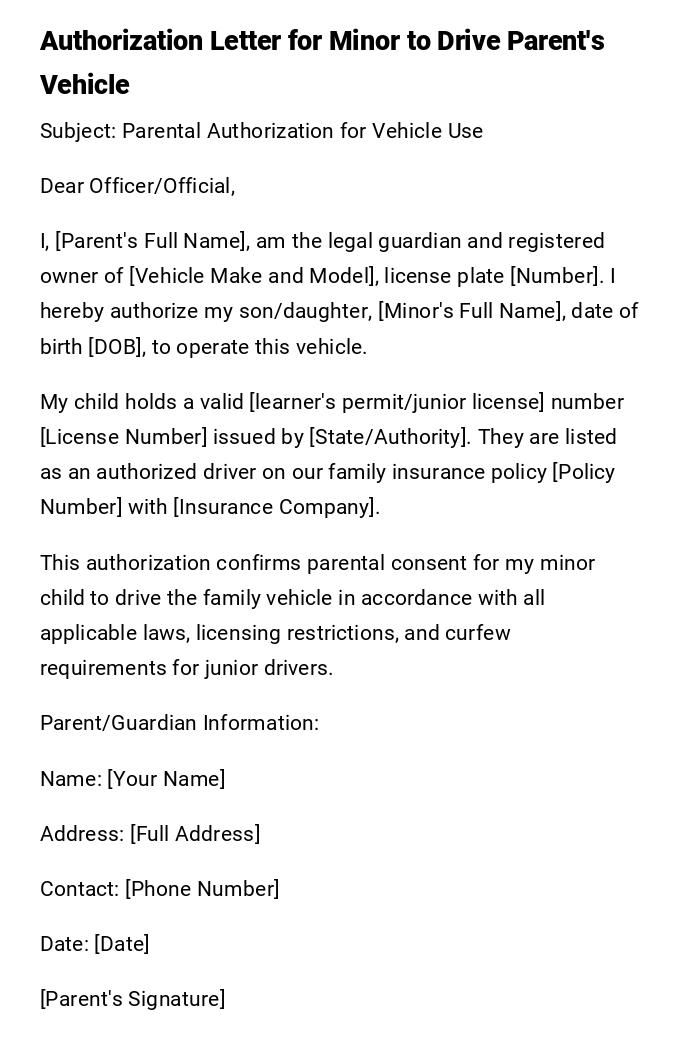
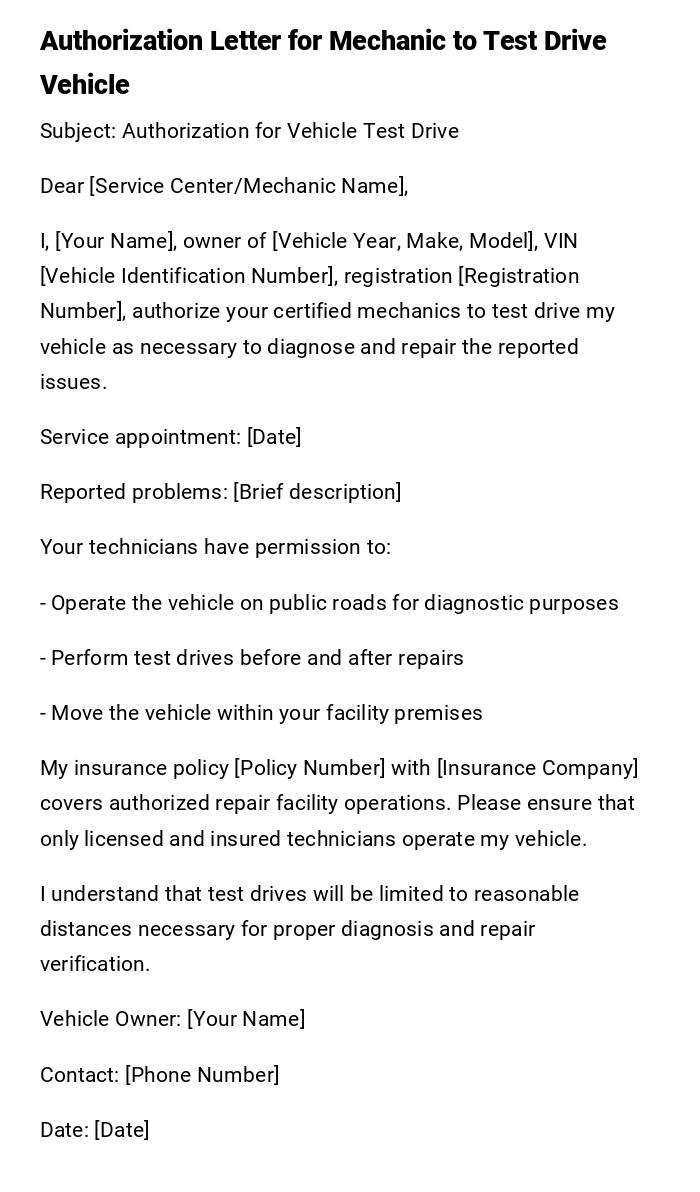
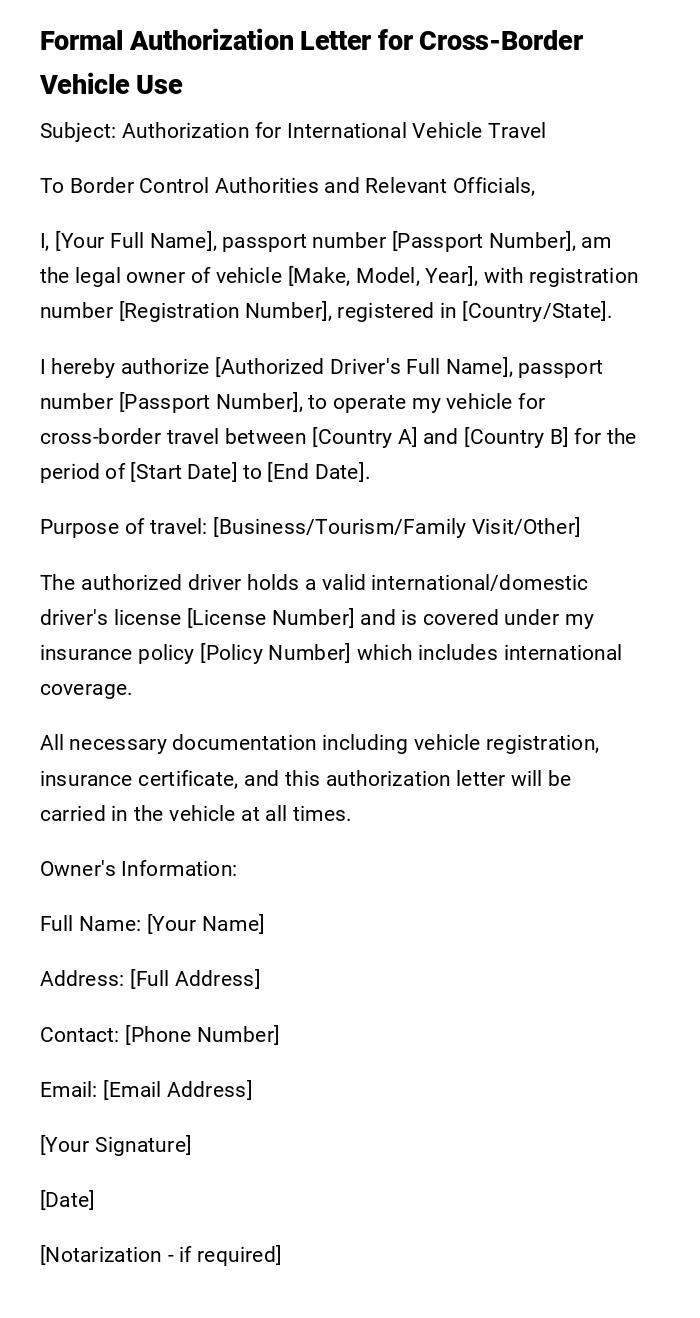

 Download Word Doc
Download Word Doc
 Download PDF
Download PDF